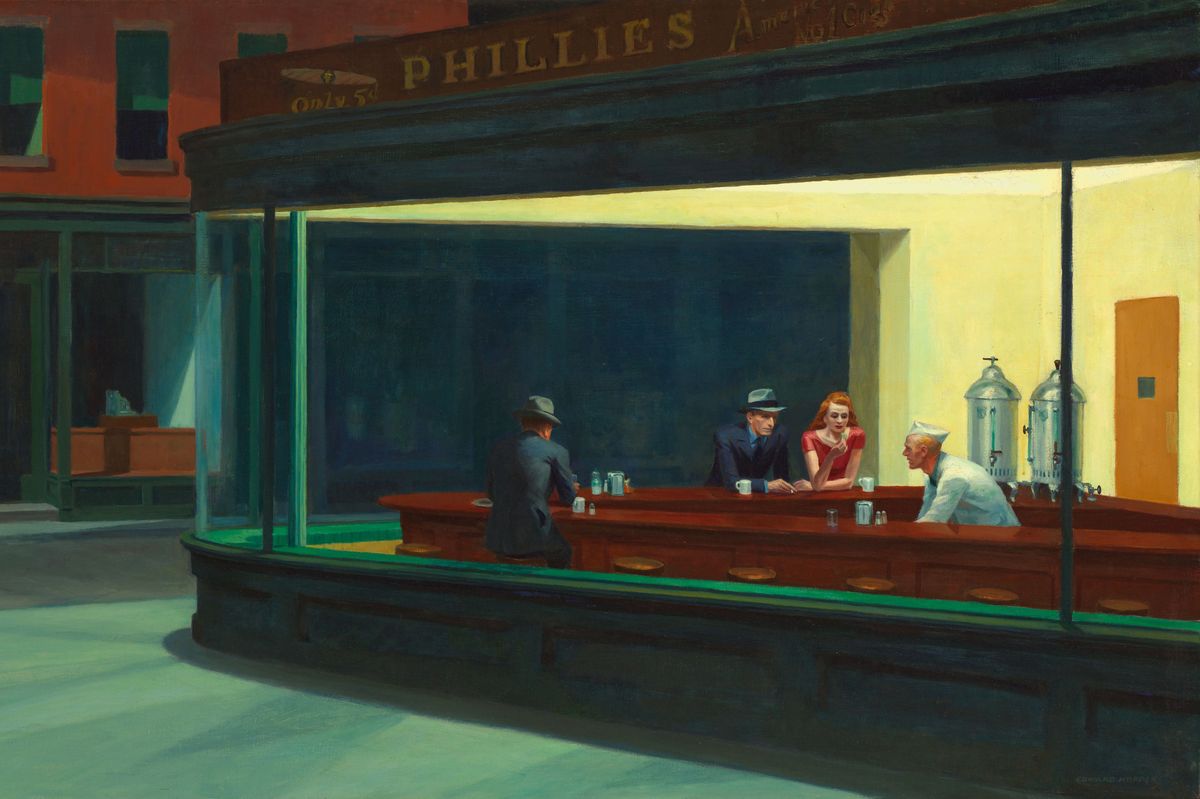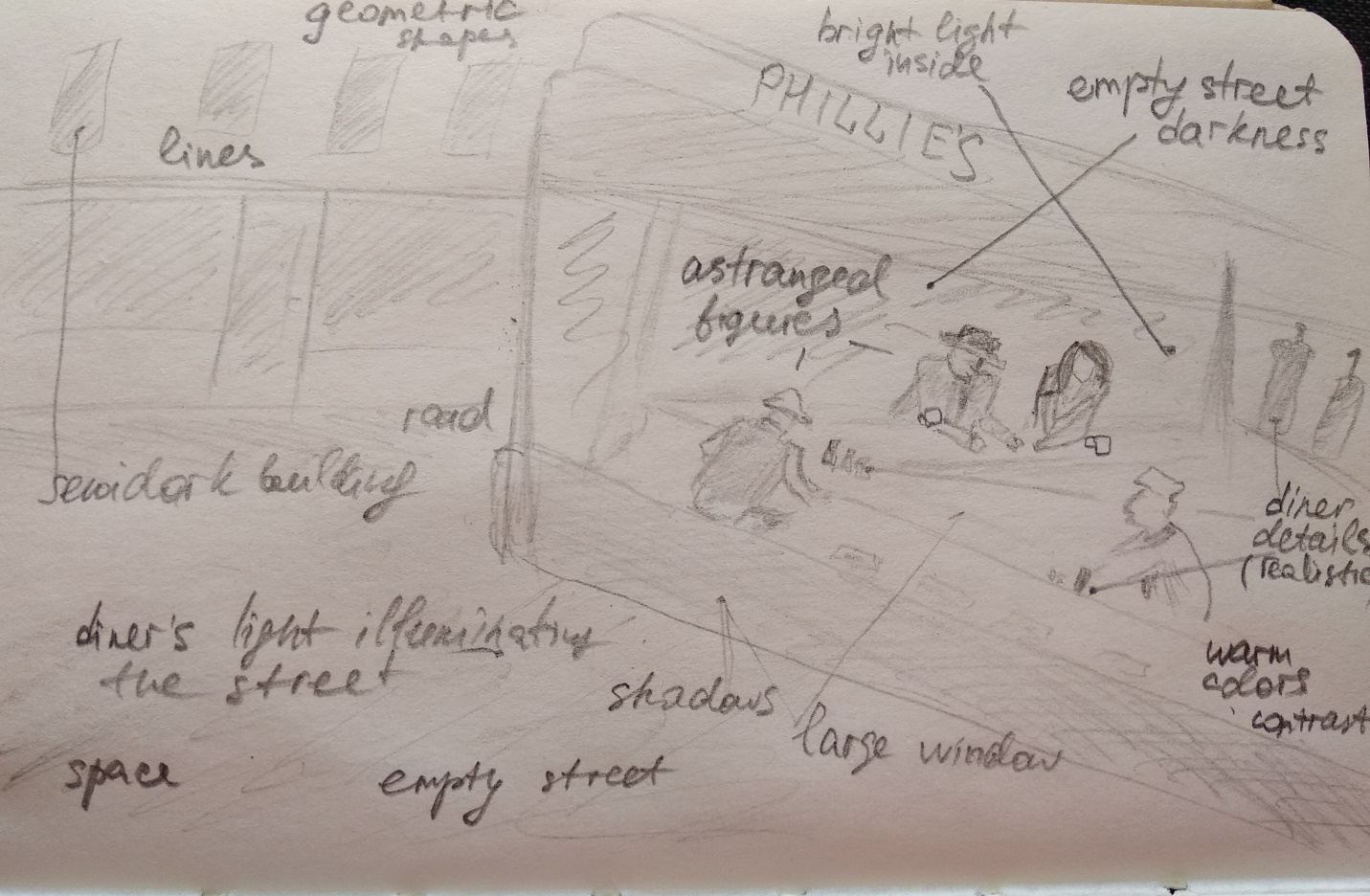

Introduction
American art of the twentieth century presents numerous examples of paintings that illustrate the life of Americans in that historical period. One of the most memorable and important artworks of American modernist art is Edward Hopper’s painting titled Nighthawks. The work was created in 1942 during World War II when the USA, as well as the rest of the world, was coming through a social crisis (Hopper, 1942). This relatively large painting with dimensions of 84.1 × 152.4 cm (33 1/8 × 60 in) was created using oil on canvas. It is currently located and displayed at the Art Institute of Chicago.
The painting portrays a city street corner where the restaurant is situated. The right side of the painting presents the interior of the diner with bright light inside illuminating the empty street. The viewers can see the inside of the diner through a large glass window. There are four people in the diner, including three visitors (two men and a woman) and a bartender behind the counter. The visitors are sitting on chairs; they have cups, napkin holders, salt and pepper containers, and glasses near them on the counter. The shape of the counter follows the shape of the corner of the building and is curved at 90 degrees angle. Such a positioning of the counter allows the viewers to see the front and the side views of the restaurant. Against the far wall inside the diner, there are two large coffee tureens and an orange door leading to the kitchen.
One of the men sits far from others with his back facing the front of the picture. Another man and a woman are sitting on the opposite side with their faces toward the front of the picture. The bartender is wearing a white shirt and a white cap; he is looking outside the window into the dark emptiness of the street and the semi-dark building across the road. The woman is wearing a bright red short-sleeved dress, which compliments her red hair.
The people are not interacting in the painting; they sit separately. It is late night, as implied by the outside darkness of the city street. The restaurant is the only light that illuminates the empty space outside. The building in the background is pictured in the shadows with dark and empty windows and glass doors. The depth of darkness in the building is opposed to the bright contrasting colors and lightness of the diner.
The viewers’ eyes are drawn to the figures of people at the counter whose appearances and wardrobe elements are portrayed in great detail. The artist uses straight lines, geometric shapes, and correct proportions to create a realistic, almost photograph-like image. Thus, in his painting Nighthawks, Edward Hopper masterfully combines the uniqueness of composition, light and shadow, geometric shapes, empty space, color and contrast, and detailed depiction of objects to convey a realistic and modernist view on the post-war isolation and loneliness in American society.
Nighthawks Painting Analysis
The Description of the Elements of Art
The seeming simplicity of the painting that illustrates several figures behind the glass window of a diner on the overall empty-spaced background is achieved by means of a masterful combination of the elements of art. One of the elements that play a pivotal role in the painting is color. Hopper uses bright warm colors combining yellow walls, red dress and hair, orange kitchen door, and acid-green exterior to emphasize the comfort of the diner late at night. At the same time, dark colors used for the background allow for creating shadows and depth of the emptiness of the street and the background building.
Straight lines and geometric figures and shapes allow the painter to convey strictness and realistic features of the city setting. The simple and correct usage of lines and geometrically proportionate elements in architecture, counter, windows, cups, glasses, and chairs create a realistic atmosphere. Space, as an element of art, is particularly relevant to the artwork because a large part of the painting is occupied by the empty space of the street. Also, the distance between the people in the painting creates the space that conveys the feelings of isolation and loneliness of the people in the night city. Moreover, values created by light interior and dark exterior build the depth of the painting, although the colors are sharply interchanged without vividly noticeable gradation.
The Description of the Principles of Design
In Nighthawks, Hopper uses the contrast of colors creating a bright interior of the diner. The combination of darkness and light is essential to the painting since it emphasizes the restaurant as the central element of the work as opposed to the dark and shadowed background. A vivid feature of the work is the illuminating light of the window on the pavement that is painted using a variety of colors with dominant green and light-yellow. People’s figures are a focal point of the picture, which attracts viewers’ eyes due to color and light placement. Correct proportions with emphasis on architecture form a realistic space characteristic to city landscapes, which serves as additional guidance for the audience concerning the setting. Hopper uses a unique composition of the corner building that allows seeing the diner from both front and side views.
Balance in the artwork is achieved through the combination of a large restaurant seeing behind the window and small background building elements in the shadow and darkness of the night. The emphasis is put on diner interior and figures; it is achieved by means of the detailed depiction of glasses, cups, napkin holders, and other typical American diner elements. While Hopper masterfully uses contrast, proportions, composition, balance, and emphasis, it seems that he intentionally minimizes movement and variety in the painting.
Such a method might be considered as a way of highlighting the stillness of the moment and the implied isolation and loneliness of the people in the city. Indeed, the picture lacks movement, with only a hint of the direction of the road turning the corner. Otherwise, the attention is drawn to the figures in the diner, whose poses imply stillness. Similarly, there is no variety of elements in the painting, with large portions of the canvas devoted to empty space. Such a design approach might emphasize the feeling of isolation.
The Medium and its Characteristics
Nighthawks is an oil on canvas painting, which allows the artist to build building color depth and intensity. Hopper uses oil to portray the shadowed details of the background building in the darkness. The interplay of light-green strokes on the black surface illuminates the darkness of the empty space. Similarly, the oil helps the painter to create the illumination of the street in the front of the picture, as well as convey the visible curve of the glass window in the corner. There are no visible texture elements that would influence the perception of the artwork.
Personal Response to the Work
Edward Hopper’s Nighthawks is a captivating illustration of American reality and culture. The artist’s masterful combination of elements of art and principles of design creates deep meaning and social relevance of the art piece. Since it was created during the war, one might assume that the lack of interaction between the people and the overall emptiness of the streets implies closed and isolated feelings that people felt during that time.
On the other hand, the painting is timeless since its simplicity underlines the loneliness of an average person in a big city. Despite the detailed depiction of the elements inside the diner, the artist does not explicitly depict the characters in the painting, leaving the viewers wondering who those people are and how they are related to each other. Such interplay of mystery and the simplicity of a casual everyday situation captures attention and builds depths of the painting’s meaning.
Conclusion
Edward Hopper’s Nighthawks is a vivid illustration of American life in the middle of the twentieth century. The simple scenery of a late-night city diner with three visitors and a bartender is attributed with great art depth. The artist creates his masterpiece using bright warm colors contrasting with each other and with the darkness of the empty spaces in the background. The play of light and shadow creates the depth of the space, while geometric shapes and lines help to build balance and proportion. In such a manner, Hopper puts emphasis on the lonely figures behind the counter without adding much movement or variety to the scene. Thus, the painting conveys the feelings of loneliness and isolation of American people in a big city during the war.
Reference
Hopper, E. (1942). Nighthawks[painting]. The Art Institute of Chicago, Chicago, IL, United States. Web.